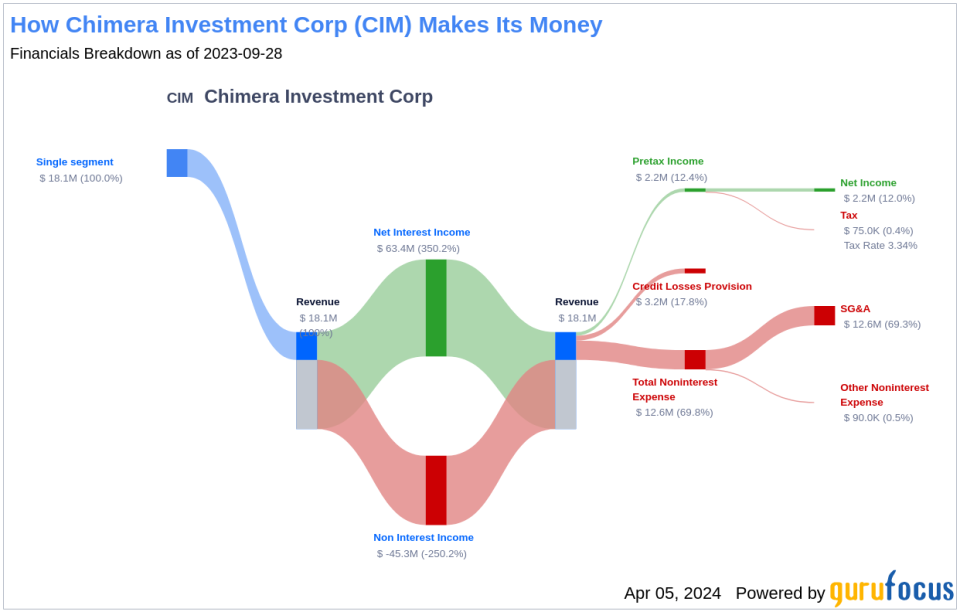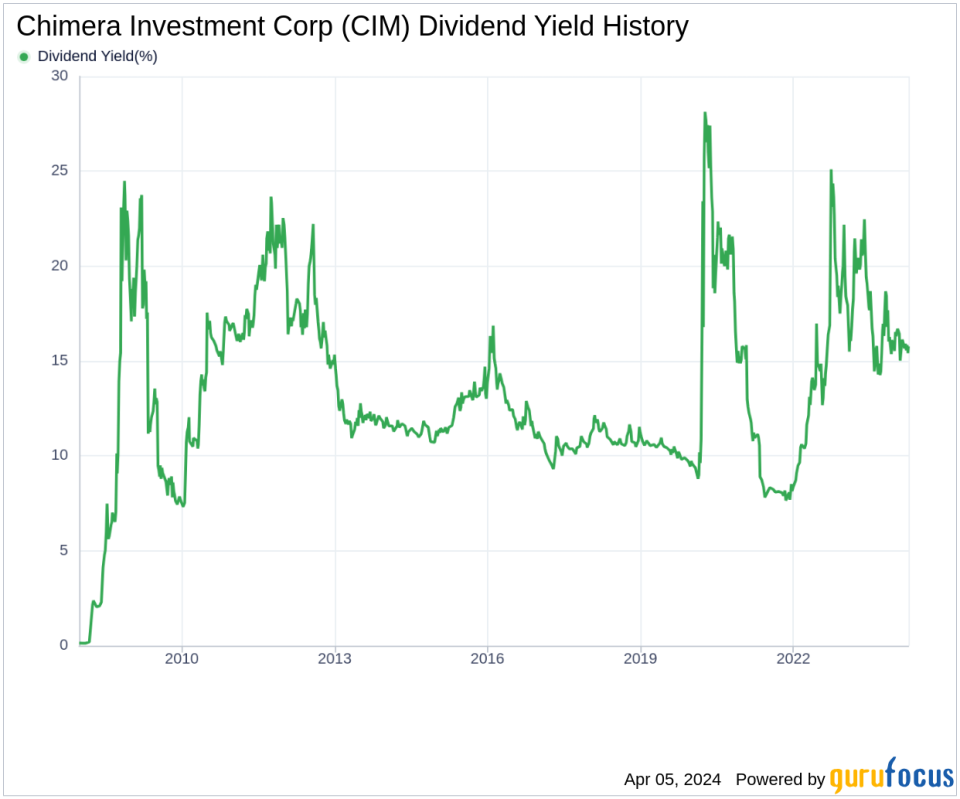Chimera Investment Corp's Dividend Analysis
Assessing the Sustainability of Chimera Investment Corp's Dividends
Chimera Investment Corp (NYSE:CIM) recently announced a dividend of $0.11 per share, payable on 2024-04-30, with the ex-dividend date set for 2024-04-05. As investors look forward to this upcoming payment, the spotlight also shines on the company's dividend history, yield, and growth rates. Using the data from GuruFocus, let's look into Chimera Investment Corp's dividend performance and assess its sustainability.
What Does Chimera Investment Corp Do?
This Powerful Chart Made Peter Lynch 29% A Year For 13 Years
How to calculate the intrinsic value of a stock?
Chimera Investment Corporation is a real estate investment trust engaged in investing in a portfolio of mortgage assets on a leveraged basis. These investments include a variety of government-sponsored agency residential mortgage-backed securities, or RMBS, non-agency RMBS, agency commercial mortgage-backed securities, residential mortgage loans, and other real estate-related securities. Agency mortgage-backed securities represent the largest share of this portfolio, while subprime residential mortgage loans and non-agency RMBS also make up substantial shares.
A Glimpse at Chimera Investment Corp's Dividend History
Chimera Investment Corp has maintained a consistent dividend payment record since 2007. Dividends are currently distributed on a quarterly basis. Below is a chart showing annual Dividends Per Share for tracking historical trends.
Breaking Down Chimera Investment Corp's Dividend Yield and Growth
As of today, Chimera Investment Corp currently has a 12-month trailing dividend yield of 15.75% and a 12-month forward dividend yield of 9.89%. This suggests an expectation of decreased dividend payments over the next 12 months.
Over the past three years, Chimera Investment Corp's annual dividend growth rate was -20.60%. Extended to a five-year horizon, this rate increased to -18.30% per year. And over the past decade, Chimera Investment Corp's annual dividends per share growth rate stands at -7.40%.
Based on Chimera Investment Corp's dividend yield and five-year growth rate, the 5-year yield on cost of Chimera Investment Corp stock as of today is approximately 5.73%.
The Sustainability Question: Payout Ratio and Profitability
To assess the sustainability of the dividend, one needs to evaluate the company's payout ratio. The dividend payout ratio provides insights into the portion of earnings the company distributes as dividends. A lower ratio suggests that the company retains a significant part of its earnings, thereby ensuring the availability of funds for future growth and unexpected downturns. As of 2023-12-31, Chimera Investment Corp's dividend payout ratio is 1.55, which may suggest that the company's dividend may not be sustainable.
Chimera Investment Corp's profitability rank, offers an understanding of the company's earnings prowess relative to its peers. GuruFocus ranks Chimera Investment Corp's profitability 3 out of 10 as of 2023-12-31, suggesting that the dividend may not be sustainable. The company has reported net profit in 9 years out of the past 10 years.
Growth Metrics: The Future Outlook
To ensure the sustainability of dividends, a company must have robust growth metrics. Chimera Investment Corp's growth rank of 3 out of 10 suggests that the company has poor growth prospects and thus, the dividend may not be sustainable.
Revenue is the lifeblood of any company, and Chimera Investment Corp's revenue per share, combined with the 3-year revenue growth rate, indicates a strong revenue model. Chimera Investment Corp's revenue has increased by approximately -4.20% per year on average, a rate that underperforms approximately 80.45% of global competitors.
The company's 3-year EPS growth rate showcases its capability to grow its earnings, a critical component for sustaining dividends in the long run. During the past three years, Chimera Investment Corp's earnings increased by approximately -47.40% per year on average, a rate that underperforms approximately 93.99% of global competitors.
Next Steps
In conclusion, while Chimera Investment Corp has demonstrated a history of consistent dividend payments, the current data suggests caution. The declining dividend growth rate, high payout ratio, and low profitability and growth ranks raise questions about the future sustainability of its dividends. Investors should closely monitor the company's financial health and industry trends when considering Chimera Investment Corp as a potential investment for income. GuruFocus Premium users can screen for high-dividend yield stocks using the High Dividend Yield Screener.
This article, generated by GuruFocus, is designed to provide general insights and is not tailored financial advice. Our commentary is rooted in historical data and analyst projections, utilizing an impartial methodology, and is not intended to serve as specific investment guidance. It does not formulate a recommendation to purchase or divest any stock and does not consider individual investment objectives or financial circumstances. Our objective is to deliver long-term, fundamental data-driven analysis. Be aware that our analysis might not incorporate the most recent, price-sensitive company announcements or qualitative information. GuruFocus holds no position in the stocks mentioned herein.
This article first appeared on GuruFocus.

 Yahoo Finance
Yahoo Finance 

